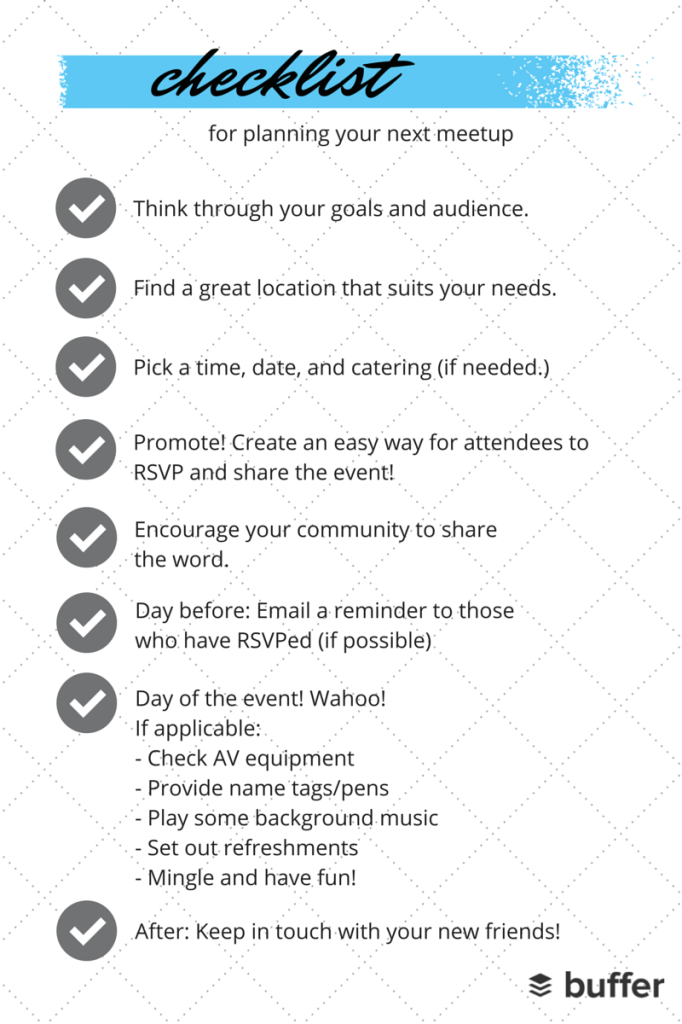
How to Host a Meetup For Your Community: The Who, What, Where, When, And How
Director of People @ Buffer
With a distributed team of 26 (and growing!) and 1.5 million amazing customers across the globe, a vast majority of our interactions are online and through a variety of apps and tools to keep connected.
In addition to all these amazing ways to connect online, we’ve hosted several Buffer meetups. For the same reason our team bounds off for international working retreats every five months, we have found in-real-life meetups with our fantastic community members to be invaluable.

Meetups (or if organized through Twitter, “Tweetups”) can originate from brands or from the communities themselves.Communities band together and share experiences based on common interests, and it strengthens ties among the community and to the brand.
For example, the app RunKeeper uses the site meetup.com to allow its users to find meetups across the world. It’s a great way for users to connect with other RunKeeper community members.
In-person meetups are perfect for creating deeper relationships with your community. Whether offering a question-and-answer format, a presentation, or networking, they can often unearth a host of conversations and questions that might never surfaced through a relationship.
A look at some of Buffer’s past meetups
For the Buffer meetups we have planned, we have also strove to bring together the community to meet Buffer team members. These meetups have ranged from casual coffee for a handful of people to fully planned events for a crowd of nearly 1oo.
At Buffer, our meetups have originated rather organically — a team member might have been in the area or another team member facilitated much of the legwork. While a community manager might typically take the lead to orchestrate a meetup, these events could be led by anyone within the organization who might have a passion for networking and interacting with your audience.
In Chicago, our Chief Happiness Officer, Carolyn, was in town for a conference and we thought it’d be great to have a small gathering for Buffer to buy some coffee and pastries for our awesome community. She was able to meet with six Buffer fans and had a great time.

In Manchester, UK, our Happiness Hero, Dave, coordinated a meetup at the coworking space, TechHub, where our founder, Joel, had spent a lot of his time in the past. Joel was even able to join via Google Hangout and share some of the Buffer story!
Hangout with @joelgascoigne underway #bufferMCR pic.twitter.com/wkSAAQJHDW
— Holding (@jkdlsalsjdg) June 8, 2014This audience in particular was more interested in startups and the story behind the company, so we tailored our agenda to match those interests.
In New York, when the whole Buffer team was present for our retreat, we held a meetup at Projective Space where we mingled with 80+ guests ranging from users to industry partners.

We also chatted a little about the company culture and also the future of Buffer.

Meeting Buffer community members face-to-face is a true delight. Conversations and insights emerge. Here are a few insights we’ve gained from our meetups and how they might help you plan your own community gathering!
The Who: Finding your community
When it comes to the who, knowing exactly what audience you are targeting with your event will determine all the rest of the puzzle pieces. It’s OK to be specific or broad in your goals, but identifying these is a great start to planning your meetup.

A common rule-of-thumb in event planning is that about 40 percent of people who RSVP for a free event will actually attend. Keeping this in mind can help you better estimate your total attendance. However, if you have a really active and engaged audience, that percentage can definitely be higher. We were beyond thrilled with about 60 percent attending who had RSVPed at our New York meetup. (Buffer fans are awesome!)
Also, the more in-touch you are and more personal the invitation, the better idea of your total numbers you will have. We emailed several people directly for our New York meetup and knew that those folks would definitely be there.
The What: Structuring your event
When it comes to the structure of meetups, there are really no “rules” — it can be as fluid or organized as you would like. If you know your audience and what they might be expecting, plan accordingly. Will there be a question-and-answer panel? Just networking?

For the community manager, your role during the event may vary depending on your structure. If you have a hosted Q&A or presentation, you might need to act as the emcee. If there are refreshments, you might act as the caterer to refill dishes. You might float around through the crowd, make sure people are mingling and feeling welcomed. If there are any guests who might be lonely, be sure to say hello! As with online interactions, you have the incredible opportunity to reach out and extend a hand (literally and figuratively) that can help bond your community together.
The When: Choosing a time
Knowing your target audience should help you determine what day of the week and what time of the day is ideal for your meetup. Is it a coffee meetup on Saturdays type of crowd? Or happy hour downtown on a Wednesday night kind of crowd?
If you’re not sure, take the opportunity to ask! Activate your community and even ask for suggestions if you’re stuck. This allows your fans to play a role in the event and take on some ownership of it.
The Where: Selecting a venue
The venue is most dependent upon how many attendees you expect. For our coffee hangouts, we planned around coffee shops as we were’t expecting large crowds. Still, we made phone calls to the shops themselves to give a friendly heads-up, which seemed to be appreciated by the staff.
If you expect more than six or eight attendees, you’ll want to look for a large enough room and factor in some refreshment costs. For several of our meetups, we have utilized coworking spaces. It feels great to support these spaces, and they are typically available for event rentals and provide wide open layouts that are great for meeting and mingling.

The How: Promoting your meetup
Ensuring that you get the word out about your meetup is key.
In the Buffer meetups that we have organized, we typically promoted the event 2-3 weeks beforehand, which seemed to allow for good exposure. In many cases, we even reached out to customers by email to invite them one on one. This yielded a great return and also allowed for more of a connection and opportunity to touch base.
For many of our meetups, we created special graphics with the date, time and location of the meetup. You can use online tools like Canva to easily create attractive graphics that will stand out on social media. Images help you stand out from the crowd and you could use these visuals in any blog posts promoting the event, or on the event invitations themselves.
Depending on the size and scope of your audience, you could allocate some funds to Facebook to custom-target your posts and amplify your reach. On Twitter, use hashtags for the location or use the handle of the event space if there is one. Post to as many accounts and networks as needed to reach your desired audience. Targeting your Facebook posts can also help so that only the audience you want to see your posts will see them.
Ask your community to help you spread the word! For events where you have space limitations or catering, encourage people to RSVP and make it very easy to do so. It also helps to give a deadline for RSVPs (especially if your space is limited.) Deadlines create a sense of urgency that can help drive action.
Here are a few helpful tools for promotion:
- Meetup.com is a site where you can find meetups or create meetups of your own.
- Eventbrite is a powerful event organization tool and free to use for free events.
- Facebook events and Google+ Events are great ways to create a place for people to reference and RSVP.
Depending on the venue, you may be able to advertise to their contacts through an email newsletter or posting on an events board.
There are many other tools and apps out there — we’d love to hear what you use or what you recommend!
Be sure to follow up after your event and build upon these foundations for even closer connections to your community. At Buffer, we had the privilege to meet a lot of our Twitter chat (#bufferchat) participants at our meetup. This allowed for some really great conversations at our Twitter chat the next week!
Another way we followed up with our New York meetup participants was an email afterwards thanking those who RSVPed and attended (a really simple function with Eventbrite). We also asked for addresses and tshirt sizes for those who didn’t get a shirt at the event. In the weeks following the event, we mailed out about thirty shirts and personalized thank-you cards. This felt like a really great way to thank our friends for coming out to our event and meeting the team.

To Wrap it Up
There is certainly no one way to organize a meetup, and for each group or company, your event will be unique. That’s what makes these in-person activities so exciting and so worthwhile. The amount of emotion and communication conveyed in face-to-face interactions cannot be substituted.
If you are planning a meetup, it can be good to start small and build as your experience grows. Event planning is an exciting and ever-evolving skill that takes practice above all else. It’s also great to involve fellow team members or collaborators to help plan your events. Meetups can bring your whole company and community closer together.
I’d love to hear about your meetups, tweetups and more. Share any meetup experiences or advice you have in the comments!
Try Buffer for free
140,000+ small businesses like yours use Buffer to build their brand on social media every month
Get started nowRelated Articles

I spoke to leading B2B content marketers (an in-house content director, agency owners, top freelancers, and thought leaders) to find out what they think B2B brands can do to create good content in 2024.

Black Friday and Cyber Monday marketing guidance to help you stand out from the crowd — complete with tried-and-tested examples.

Over the past two years, Buffer’s Senior Growth Marketing Manager, Sophie, has run 25 A/B tests in Google Adwords. In this article, she shares her strategic approach to conducting successful marketing experiments, how to come up with new experiment ideas, and the lessons she’s learned along the way.